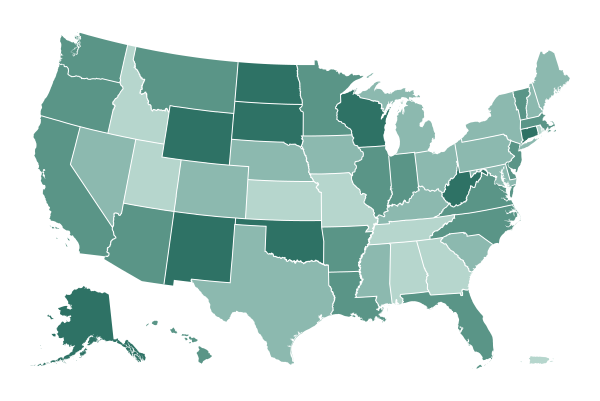CAPE TOWN — South Africa will share its unused doses of the AstraZeneca-Oxford vaccine with the African Union, the country’s health minister said on Tuesday.
South Africa, which had bought 1.5 million doses of the vaccine, decided to pause plans to distribute it this month after a small trial failed to show that it could prevent mild or moderate cases of Covid-19 caused by the variant that has overrun the country.
“The AstraZeneca doses which we purchased have been offered to the African Union platform, which we are part of, and they will be distributed to the countries that have already indicated interest that do not have this particular challenge of this variant,” the country’s health minister, Dr. Zweli Mkhize, told the Parliament. “There will therefore be no wasteful and fruitless expenditure.”
The scientists involved in the South African study said that they believed the AstraZeneca vaccine might still protect against more severe cases caused by the virus variant, based on the immune responses detected in blood samples from people who were given it.
A World Health Organization panel of experts recently recommended that the AstraZeneca vaccine be used in countries where concerning new variants of the coronavirus are circulating, cautioning that it was difficult to draw firm conclusions from such preliminary data. But the panel also said that each country should take into account the state of the virus and the type of variants spreading there in deciding which vaccines to use.
Instead of the AstraZeneca-Oxford vaccine, South Africa was planning to inoculate health workers with the Johnson & Johnson vaccine, which prevented hospitalizations and deaths in clinical trials in the country.
The ministry did not say whether the African Union would be buying the doses, accepting them as a donation, or exchanging them for an alternative. The regional body declined to comment.
Dr. Mkhize also rejected a report from an Indian newspaper, The Economic Times, that South Africa had asked the manufacturer of its doses, the Serum Institute of India, to take them back.
“We also want to refute categorically the speculation in the media that we have returned the stock to India. We have not,” said the health minister.

Gov. Andrew M. Cuomo of New York wrote the book on pandemic leadership, literally. He won an International Emmy for his TV briefings during the outbreak’s early months. Now, his self-created image as America’s Covid-19 governor may be threatened by his efforts to protect it.
Mr. Cuomo conceded on Monday that his administration’s lack of transparency about how it counted coronavirus-related deaths in the state’s nursing homes had been a mistake.
The pandemic has ravaged nursing homes across the country. But as recently as late January, New York was reporting only about 8,500 nursing-home fatalities, excluding virus-related deaths that occurred outside those facilities, such as in hospitals. Now, with those included, more than 15,000 residents of New York’s nursing homes and long-term care facilities are known to have died from Covid-19.
The spike came after the state’s attorney general, Letitia James, accused the Cuomo administration of severely undercounting deaths connected to nursing homes. The state quickly updated those numbers, adding thousands. A court order has since led to more updates and an even higher number.
Speaking Monday in the State Capitol, Mr. Cuomo made his first remarks since a top aide to the governor, Melissa DeRosa, privately told some state lawmakers last week that the state had withheld data from the Legislature. She said it had feared that the Trump administration would use the information to begin a federal investigation into the state’s handling of nursing homes.
The governor echoed Ms. DeRosa’s comments and acknowledged that by failing to answer questions from state lawmakers, the public and the news media, the state created a void that was “filled with skepticism, cynicism and conspiracy theories which furthered confusion.”
The revelation that data was withheld from lawmakers has prompted accusations of a cover-up and calls from lawmakers in both parties for the Democratic governor to be investigated and stripped of the emergency powers that he has exercised during the pandemic.
President Trump’s Justice Department never formally opened an investigation. But the episode has cast a shadow on the governor’s record on nursing homes, darkening his carefully cultivated image as a competent executive beholden to facts. In October, Mr. Cuomo published a memoir, “American Crisis,” offering “leadership lessons” from his approach to the pandemic, which has killed more than 45,000 people in New York.
The nursing-home revelations are “really potentially politically problematic” for Mr. Cuomo, who plans to run for a fourth term in 2022, said Patrick Egan, a political-science professor at New York University. But he added that if the governor successfully pushes for the vaccinations of large numbers of New Yorkers, his transgression “may be long forgotten.”
New York ranks 38th among states in vaccinating its population with at least one shot, according to a New York Times database.
The governor has been eager to expand vaccine access, most recently to millions of New Yorkers with chronic health conditions. He has done so even as demand outstrips supply by far.
New Yorkers lined up to receive the vaccine at sites around the city on Monday, a day after people inundated a state website and call center and found a shortage of appointments.
Last month, state officials scrambled to loosen vaccine eligibility restrictions after medical providers said they had to throw out vaccine doses because they were struggling to find patients who fit the guidelines.
Vaccination bottlenecks “could very quickly resolve themselves,” Dr. Egan said, but Mr. Cuomo’s reputation as a pandemic leader could lose its luster if investigations brought damaging revelations.
“We just don’t know if it’s going to metastasize into a bigger problem,” he said. “Are there more things that the government withheld?”
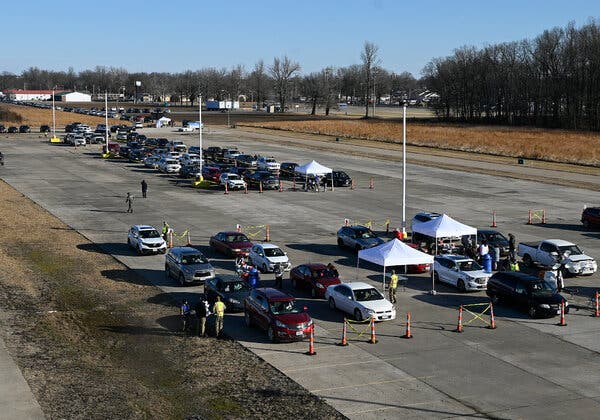
The winter storm stretching across much of the United States disrupted distribution of the coronavirus vaccine this week, as clinics giving shots were closed and shipments of the vaccine were stalled as snow and ice grounded flights and turned highways dangerously slick.
Many of the closures and cancellations were in the South, where the storm was particularly fierce — and where the pace of vaccinations in several states has lagged behind the national average. On Monday, vaccine appointments were rescheduled or canceled from Texas to Kentucky.
“It’s just not safe for people to be out. So we need this to thaw,” Mayor Steve Adler of Austin said Tuesday on CBS. “And then we’re just going to have to redouble our efforts and make sure that the vaccine that we have gets into people’s arms. But for right now, we’re on pause.”
The delays appeared likely to grow in the coming days, as the storm continued its path across the country.
In Missouri, Gov. Mike Parson said on Monday that vaccination distribution efforts run by the state would be brought to a halt through the rest of the week. “Missouri is experiencing severe winter weather that makes driving dangerous and threatens the health and safety of anyone exposed to the cold,” he said in a statement.
In Alabama, hospitals closed vaccination clinics, as did more than two dozen county health departments. In New Hampshire, state officials said vaccinations would be canceled on Tuesday.
The storm’s impact on vaccine distribution seemed national in scope. Health officials in Washington State, where the storm came and went, said they were dialing back vaccination plans later this week because they anticipated delays in the delivery of new doses. Mr. Parson of Missouri said the weather would likely interfere with some vaccine shipments to his state as well.
In Tennessee, vaccine appointments have also been rattled by the storm. The Hamilton County Health Department, in the southeastern part of the state, said that it would be rescheduling all vaccine appointments scheduled for Tuesday.
“Our main priority is providing a safe environment for staff and community members,” the department’s administrator, Becky Barnes, said in a statement.
In Detroit, Mayor Mike Duggan said the 3,000 vaccination appointments scheduled to be carried out on Tuesday at the TCF Center, a convention center downtown, would be moved to the same time on Saturday.
“We’re just going to have to work through this as a community,” Mr. Duggan said. “We’re going to keep the vaccines going to the maximum extent possible, but we’re also not going to ask people to be put at risk coming down in difficult driving conditions.”
GLOBAL ROUNDUP
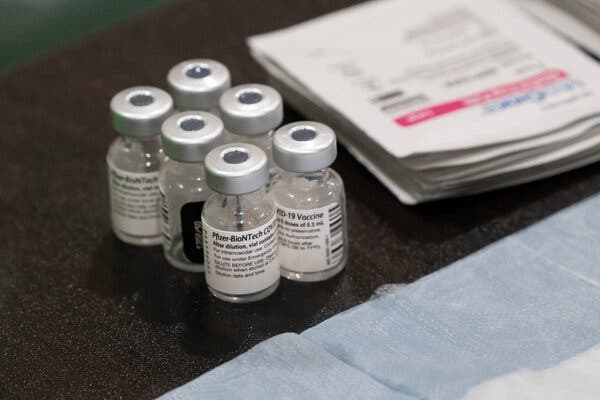
North Korea has tried to steal Covid-19 vaccine and treatment technology by attempting to hack the computer systems of international pharmaceutical companies, including Pfizer, a South Korean lawmaker said on Tuesday after a briefing by government intelligence officials.
The North, which has a decrepit public health system, claims officially to be free of Covid-19. It sealed its borders early last year.
The South Korean lawmaker, Ha Tae-keung, who is affiliated with the opposition People Power Party, spoke to reporters after he and other lawmakers were briefed by senior officials from the National Intelligence Service in a closed-door session on Tuesday.
Mr. Ha provided no further details, and the service declined to corroborate his remarks, citing a policy of not confirming information from such briefings. Pfizer did not immediately respond to a request for comment.
Western officials have long accused North Korea of stealing technology and cash from the outside world through hacking. Last week, the Reuters news agency reported that a preliminary United Nations inquiry into the theft of $281 million worth of assets from a cryptocurrency exchange last September “strongly suggests” links to North Korea.
In other developments around the world:
-
Johnson & Johnson has submitted its single-shot Covid-19 vaccine to the European Union’s drug regulator for authorization, the agency said Tuesday. The vaccine could be approved by mid-March if it meets criteria for safety, efficacy and quality, the regulator, the European Medicines Agency, said in a statement. It would then be the fourth vaccine cleared for use in the union, raising hopes that member nations would be able to speed up immunization programs that have gotten off to sluggish starts.
-
Colombia, which will start vaccinations on Wednesday, is kicking off its campaign in a rural part of the country to signal that the vaccines will be available for everyone, not just those in major cities, President Iván Duque said. Colombia has had the second worst coronavirus outbreak in Latin America, and is beginning vaccinations weeks after neighboring countries like Chile and Argentina.
-
A court in the Netherlands ruled that the country’s 9 p.m. curfew to curb the spread of the coronavirus must end immediately, saying there was no “special urgency” to justify it. The court called the curfew, which the government instituted without input from the Parliament, a “far-reaching violation of the right to freedom of movement and privacy.” Last month, after the curfew went into effect, violent demonstrations erupted across the country for multiple nights on end, in which people looted stores and threw rocks at the police.
-
Germany plans to provide free, rapid-turnaround tests for coronavirus antigens starting on March 1, Jens Spahn, the country’s health minister, said on Twitter. They will be administered in pharmacies or test centers, he said. Currently, German health insurers pay for tests for those with symptoms or who have had contact with infected people, although rules vary across the country.

LONDON — The Zoom session that the singing coach Suzi Zumpe ran on a recent afternoon resembled those she usually leads at the Royal Academy of Music in London, or at Garsington Opera near Oxford, where she trains young singers.
This time, however, the student she was helping through warm-up exercises wasn’t a singer. He was Wayne Cameron, 56, who manages warehouse logistics for an office-supply company. Doctors prescribed the session as part of his recovery plan after a pummeling experience with Covid-19 last March.
Called E.N.O. Breathe and developed by the English National Opera in collaboration with a London hospital, the six-week program offers patients customized vocal lessons: clinically proven recovery exercises, reworked by professional singing tutors and delivered online.
In a video interview, Jenny Mollica, who runs the English National Opera’s outreach work, explained that the idea was developed last summer, when “long Covid” cases started emerging. These were people who had recovered from the acute phase of the disease but were still suffering effects like chest pain, fatigue, brain fog and breathlessness.
“Opera is rooted in breath,” Ms. Mollica said. “That’s our expertise. I thought, ‘Maybe E.N.O. has something to offer.’”
The program is now being expanded to post-Covid clinics elsewhere in England, supported by charitable donations and free to anyone who is referred by a doctor. The aim is to assist as many as 1,000 people in the next phase, the opera company said in a statement.
Mr. Cameron said that even a few simple breathing exercises had quickly made a huge difference for him. “The program really does help,” he said. “Physically, mentally, in terms of anxiety.”

Doctors across the United States have been seeing a striking increase in the number of young people with Multisystem Inflammatory Syndrome in Children, or MIS-C. Even more worrisome, they say, is that more patients are now very sick than during the first wave of cases, which alarmed doctors and parents around the world last spring.
The reasons are unclear. The surge follows the overall spike in Covid-19 in the United States after the winter holidays, and more cases may simply mean more chances for severe disease to emerge. So far, there’s no evidence that recent coronavirus variants are responsible, and experts say it is too early to speculate about any impact of variants on the syndrome.
The condition remains rare. The latest numbers from the Centers for Disease Control and Prevention show 2,060 cases in 48 states, Puerto Rico and the District of Columbia, including 30 deaths. The median age was 9, but infants to 20-year-olds have been afflicted. The data, which is complete only through mid-December, shows the rate of cases has been increasing since mid-October.
While most young people, even those who became seriously ill, have survived and gone home relatively healthy, doctors are uncertain whether any will experience lingering heart issues or other problems.
“We really don’t know what will happen in the long term,” said Dr. Jean Ballweg, the medical director of pediatric heart transplant and advanced heart failure at Children’s Hospital & Medical Center in Omaha, which treated about two hospital cases a month from April through October, about 30 percent of them in the I.C.U. That rose to 10 cases in December and 12 in January, with 60 percent needing I.C.U. care — most requiring ventilators.
Symptoms of the syndrome can include fever, rash, red eyes or gastrointestinal problems. Those can progress to heart dysfunction, including cardiogenic shock, in which the heart cannot squeeze enough to pump blood sufficiently. Some patients develop cardiomyopathy, which stiffens the heart muscle, or abnormal rhythm.
Hospitals say most patients test positive for Covid-19 antibodies that indicate previous infection, but some patients also test positive for active coronavirus infection. Many children were previously healthy and had few or no symptoms from their initial infection. Doctors are uncertain which factors predispose children to the syndrome.
Sixty-nine percent of reported cases have affected Latino or Black young people, which experts believe stems from socioeconomic and other factors that have disproportionately exposed those communities to the virus.
But Omaha’s hospital, where early cases were largely among children of Latino parents working in the meatpacking industry, is now “seeing a much more broad spectrum and every ethnicity,” Dr. Ballweg said.
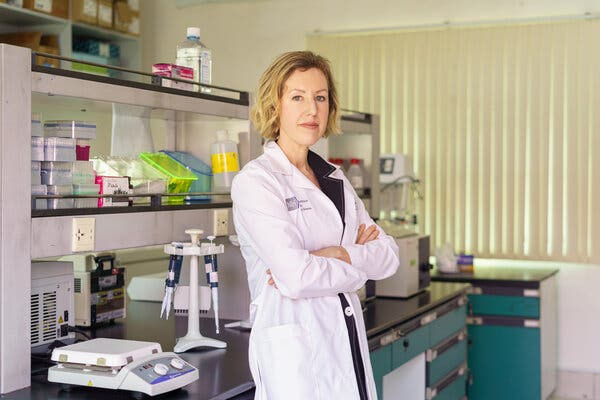
Covid-19 arrived in Cambodia a year ago, on Jan. 23, when a Chinese national flew in from Wuhan, the city where the illness was first detected, and soon fell sick with a fever. A P.C.R. test came back positive.
For Cambodia, a developing country with a rudimentary health care system and multiple direct flights from Wuhan, the new disease presented an especially high risk.
Dr. Jessica Manning, a public health researcher with the National Institute of Allergy and Infectious Diseases who had been working in Cambodia for years, also saw an opportunity: helping the country join the global effort to watch for new diseases.
In those early days of Covid-19, researchers did not know how accurate the P.C.R. tests were or whether the virus was spawning new strains with potentially different properties. The Cambodian report helped confirm the accuracy of the P.C.R. test, and it revealed that only minor changes in the sequences were appearing. The virus did not seem to be mutating substantially — an indication that the disease would be easier to test for, treat and vaccinate against.
For Dr. Manning, the exercise was proof that even a small research outpost in the developing world could successfully detect new or unexpected pathogens and glean important information about them. As such, her lab and others like it could serve as an early-warning system for the next potential pandemic.
Watching for novel pathogens in Southeast Asia has recently become an important part of the global effort to understand the pandemic. In late January, a group of researchers, most at the Pasteur Institute in Cambodia, announced that it had used metagenomic sequencing to discover a coronavirus closely related to the one that causes Covid-19 in a bat captured in Cambodia in 2010.
“This is what we were looking for, and we found it,” Dr. Veasna Duong, the leader of the study, told Nature in November. “It was exciting and surprising at the same time.”
That finding has drawn attention from researchers who want to better understand how and when viruses cross between species.
Dr. Duong is looking in particular at places where people come near fruit bats. “This kind of exposure might allow the virus to mutate, which might cause a pandemic,” he told the BBC last month.

Several gorillas at the San Diego Zoo Safari Park that tested positive for the coronavirus last month have fully recovered, the zoo said.
“We’re so grateful for the outpouring concern and support we’ve received while the troop safely recovered,” Lisa Peterson, executive director of the San Diego Zoo Safari Park, said in a statement.
Zoo officials had said they believed the animals, part of an eight-member troop of western lowland gorillas, were infected by an asymptomatic staff member who had been following safety recommendations, including wearing personal protective equipment when near animals. The gorillas, whose symptoms included coughing and congestion, were the first apes in the United States known to be infected with the virus, federal officials said.
The primate habitat where the gorillas are housed is now fully open to visitors, the zoo said. Both the San Diego Zoo and the San Diego Zoo Safari Park reopened on Jan. 30 after closing since early December under a statewide stay-at-home order. Limits on attendance and other safety measures are in place.
There have been multiple instances in the pandemic of animals becoming infected, including domestic cats and dogs, a tiger at the Bronx Zoo in New York, snow leopards at the Louisville Zoo in Kentucky and mink in Utah and Denmark. Two white tiger cubs at a zoo in Pakistan are thought to have died from Covid-19 last month. And in Seoul, South Korea, where pets can be tested free, officials said on Monday that one cat had tested positive.
Though cats and dogs can become infected, they may not get sick or show symptoms. There is no evidence that animals play a major role in spreading the virus, but people can spread it to them.
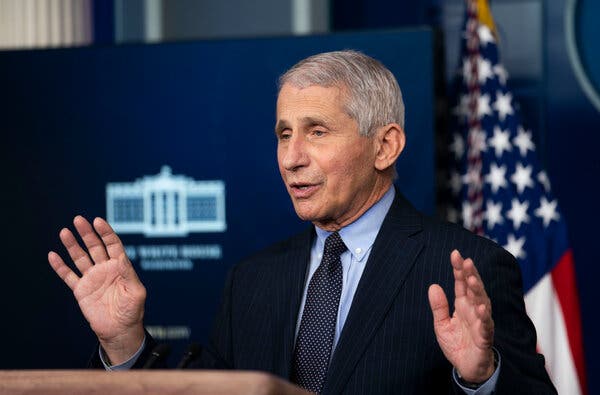
Dr. Anthony S. Fauci, the veteran director of the National Institute of Allergy and Infectious Diseases and the public face of the battle against the pandemic in the United States, has been awarded a $1 million prize from the Dan David Foundation and Tel Aviv University that is dedicated this year to outstanding contributions in public health.
The prize awards a total of $3 million a year to individuals and organizations for their achievements in three categories: expanding on knowledge of the past, enriching society in the present and promising to improve the future of the world. The theme of the prize varies from year to year. Previous laureates include the cellist Yo-Yo Ma, former Vice President Al Gore, the novelist Margaret Atwood and Dr. Demis Hassabis, an artificial intelligence researcher, neuroscientist and entrepreneur.
Dr. Fauci, 80, won in the “Present” category for his scientific contributions, including his research and his efforts to inform the public about the pandemic. He “leveraged his considerable communication skills to address people gripped by fear and anxiety and worked relentlessly to inform individuals in the United States and elsewhere about the public health measures essential for containing the pandemic’s spread,” the organizers of the Dan David Prize said in a statement.
It added, “He has been widely praised for his courage in speaking truth to power in a highly charged environment,” a reference to Dr. Fauci’s testy relations with former President Donald J. Trump and his supporters, who came to treat him as a villain.
The other Dan David Prizes were shared this year by the health and medicine historians Dr. Alison Bashford, Dr. Katharine Park and Dr. Keith A. Wailoo in the Past category; and Dr. Zelig Eshhar, Dr. Carl June and Dr. Steven Rosenberg, pioneers of an anti-cancer immunotherapy, in the Future category.

Subways in New York will soon resume running longer into the night, transit officials announced on Monday, marking a step toward the full reopening of city life.
Starting next Monday, the system will close for cleaning only from 2 to 4 a.m., instead of from 1 to 5 a.m., officials said during a news conference. They described the move as the beginning of a “phased reopening,” although they did not say when trains would again operate around the clock.
“New York is starting to return to normalcy,” said Sarah Feinberg, interim president of the New York City Transit Authority, which manages the subways.
The regular overnight closure — the first in the system’s history — began last May, as the pandemic ripped through New York. Under Gov. Andrew M. Cuomo, the Metropolitan Transportation Authority, which oversees transit in New York City, mandated the nightly closures of the famously 24-hour subway system to allow the entire system to be disinfected, a move Mr. Cuomo said was needed to reduce the spread of the virus.
The nightly cleaning of the trains will continue during the abbreviated closures, officials said.
The pandemic has decimated the finances of cities across the country and hollowed out their transit agencies — in some smaller cities, fledgling systems could be forced to shut completely. In Minneapolis, commuter rail ridership was down more than 98 percent last May compared with the previous year, according to the city’s transit agency.
On Monday, Washington’s Metrorail reduced its frequency of service for three lines during rush hour to “better match customers’ travel patterns during the pandemic” and to manage costs, the transit agency said in a statement. Its operating hours will remain unchanged, it said, though ridership on the Metrorail has declined nearly 90 percent from pre-pandemic levels.
In New York, Mr. Cuomo and other officials had previously said the subway would fully reopen only at the pandemic’s end. The phased opening appeared to signal a new approach.
In recent months, the governor has come under mounting criticism from transit activists who have argued the closure was hurting thousands of essential workers who travel at night.
About 80 percent of overnight subway riders are people of color, and a third are low-income, activists and several New York City Council members noted in a news release last week urging Mr. Cuomo to restore service.
As freezing weather has gripped the city this winter, supporters of homeless New Yorkers have also voiced concerns.
For decades, the city’s sprawling subway system has offered a shelter of last resort for thousands of homeless New Yorkers who are wary of the city’s often crowded and sometimes violent shelters.
Now, homeless people living on the streets are confronting a dangerous mix of winter weather and a lack of indoor public spaces, such as subway stations, trains and fast-food restaurants, that once offered a respite each night.
Critics of the nightly closures also have noted that scientists long ago concluded that the coronavirus spreads primarily through inhaled droplets, not via contaminated surfaces.
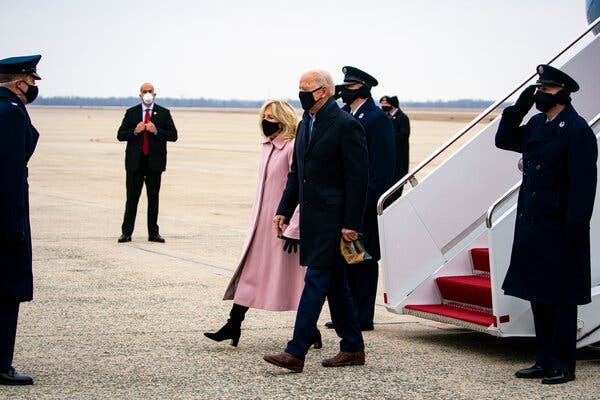
With the distraction of the impeachment trial of his predecessor now over, President Biden will quickly press for passage of his $1.9 trillion coronavirus relief plan before moving on to an even bigger agenda in Congress that includes infrastructure, immigration, criminal justice reform, climate change and health care.
Without the spectacle of a constitutional clash, the new president “takes center stage now in a way that the first few weeks didn’t allow,” said Jennifer Palmieri, who served as communications director for former President Barack Obama. She said the end of the trial means that “2021 can finally start.”
Mr. Biden has already been successful in pushing his agenda forward. House committees have begun debating parts of the coronavirus relief legislation, which he calls the American Rescue Plan. Several of his cabinet members have been confirmed, and his team is pressing Capitol Hill for quick action when senators return from a weeklong recess.
After former President Donald J. Trump was acquitted on Saturday of the charge of inciting an insurrection, Mr. Biden vowed to work across party lines to “heal the very soul of the nation.” But the president’s bipartisan prospects are complicated by the fact that much of his agenda is aimed at dismantling Mr. Trump’s policies or addressing what Democrats have cast as his failures, most significantly the fumbled response to the pandemic.
And the 43 “not guilty” votes from Senate Republicans are a stark reminder that Mr. Trump continues to hold sway over most of his party, and his influence with Republicans will be an obstacle. Even with control of both houses of Congress, Democrats will still need some Republican support on many of Mr. Biden’s agenda items to overcome a filibuster in the Senate.
Public polls show the president’s agenda to be broadly popular, even among some Republicans. That has contributed to pressure from Democratic progressives to forgo any compromises with Republicans that could water down Mr. Biden’s policy proposals. And Republicans — who are still adjusting to their loss of the Senate and the White House — have not yet coalesced around a consistent substantive attack on the president’s agenda.
Perhaps more than any previous president, Mr. Biden has used Mr. Trump as an effective political foil, constructing his agenda almost completely as a repudiation of Mr. Trump’s policies and personal behavior during his four tumultuous years in office.
On his first day in office, Mr. Biden issued a blitz of executive orders intended to undo many of Mr. Trump’s policies. And he often casts his broader agenda as the necessary response to actions taken — or not taken — by his predecessor.
The question now for Mr. Biden is whether he can take advantage of the political breathing room to build support for his proposals. And if he can, it’s unclear if the public pressure will be enough to persuade Republicans in Congress to buck Mr. Trump’s influence.



